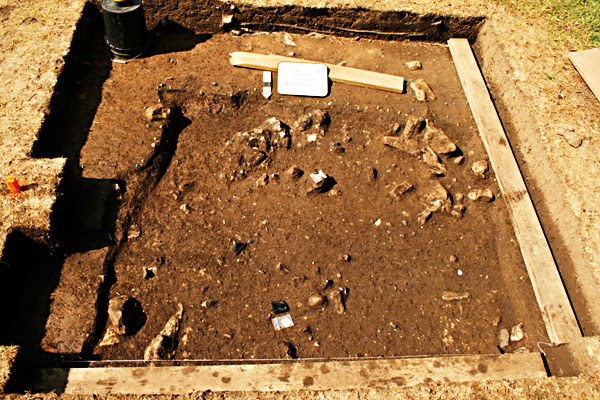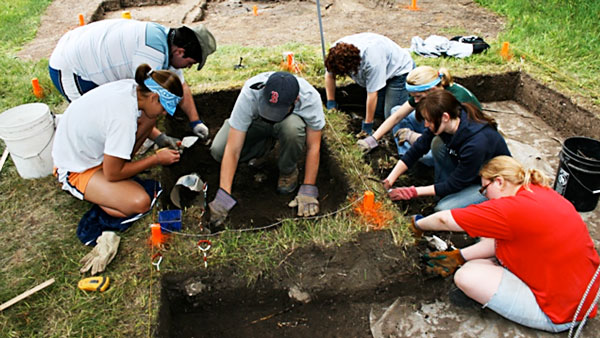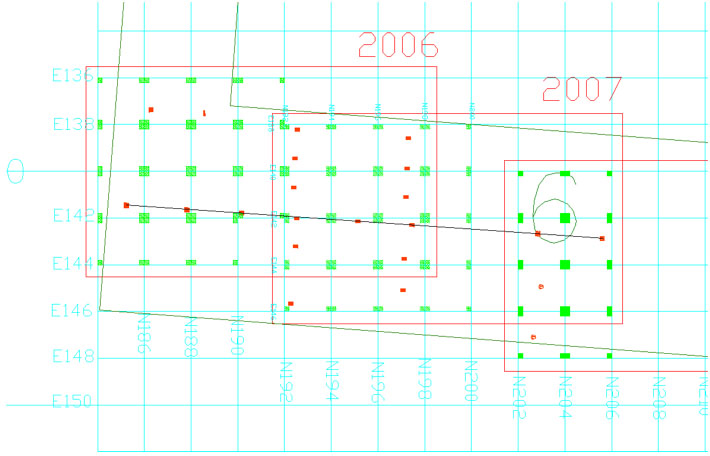by the 2008 Heidelberg College Archaeological Field Crew
 This week marked the end of our time here at Johnson’s Island, and we were very busy both in the latrine and in the hospital. At the end of last week, we spent most of the morning braving the elements while trying to keep the site dry. We had people both inside bailing out water and outside digging trenches to help with drainage. As a result we worked solely in the hospital building area, but were able to get a lot done.
This week marked the end of our time here at Johnson’s Island, and we were very busy both in the latrine and in the hospital. At the end of last week, we spent most of the morning braving the elements while trying to keep the site dry. We had people both inside bailing out water and outside digging trenches to help with drainage. As a result we worked solely in the hospital building area, but were able to get a lot done.
 After we came back from the July 4th break, we were ready to get back to work. This week has seen an increase in the visitors out at the side. We currently have six teachers that have helped all week and will remain to help Professor Bush for a week after we have left. The latrine (Feature 40) was the site of a lot of activity this week. At the start of the week we reached the end of the first level (we dig 10 centimeter levels) and spent a day mapping the artifacts and rocks found in it. After we mapped everything, we switched out people from the hospital to work in the latrine. They began to start on the next level (level 2, another 10 centimeters) Wednesday. So far, some of the more interesting artifacts that have been found in the latrine are: a green glass button, a square bottom from a glass bottle, a piece of corded material, a large metal piece, an animal tooth, and two more tin cans.
After we came back from the July 4th break, we were ready to get back to work. This week has seen an increase in the visitors out at the side. We currently have six teachers that have helped all week and will remain to help Professor Bush for a week after we have left. The latrine (Feature 40) was the site of a lot of activity this week. At the start of the week we reached the end of the first level (we dig 10 centimeter levels) and spent a day mapping the artifacts and rocks found in it. After we mapped everything, we switched out people from the hospital to work in the latrine. They began to start on the next level (level 2, another 10 centimeters) Wednesday. So far, some of the more interesting artifacts that have been found in the latrine are: a green glass button, a square bottom from a glass bottle, a piece of corded material, a large metal piece, an animal tooth, and two more tin cans.
 Inside the hospital we are continuing to work the 2×2 meter units down to their subsoil. We have five units that have been outlined in pins, mapped and photographed. One more unit is ready to be pinned and mapped Friday. We have been using the Topcon total station to map. Three of us have also been working on postholes that were found upon reaching the subsurface. Two of these (pictured here) are the main postholes from the center-line of the hospital and one is a supporting post for the side, possibly the wall. We have learned from our excavations of these that the main center postholes are square in shape while the side ones are more round. The main center postholes appear as a large square or rectangular shape that shrinks down to a square 7 by 7 inches that undoubtedly reflects the post mold of the center post. The side postholes are mostly the same size all the way down (about 15 centimeters) and slowly start to disappear near their end.
Inside the hospital we are continuing to work the 2×2 meter units down to their subsoil. We have five units that have been outlined in pins, mapped and photographed. One more unit is ready to be pinned and mapped Friday. We have been using the Topcon total station to map. Three of us have also been working on postholes that were found upon reaching the subsurface. Two of these (pictured here) are the main postholes from the center-line of the hospital and one is a supporting post for the side, possibly the wall. We have learned from our excavations of these that the main center postholes are square in shape while the side ones are more round. The main center postholes appear as a large square or rectangular shape that shrinks down to a square 7 by 7 inches that undoubtedly reflects the post mold of the center post. The side postholes are mostly the same size all the way down (about 15 centimeters) and slowly start to disappear near their end.
We have all learned the basic field techniques and all feel better about this field of study. This program has helped give us a basis for future career plans and which directions we may wish to go. One of the most valuable things we found on Johnson’s Island wasn’t an artifact, but true friendships that will last a lifetime. We came for archaeological training, but we left with a family.

by David Bush
![[image]](https://interactive.archaeology.org/johnsons/fieldreports/images_fieldreports/11July_5.jpg)
![[image]](https://interactive.archaeology.org/johnsons/fieldreports/images_fieldreports/11July_6.jpg)
![[image]](https://interactive.archaeology.org/johnsons/fieldreports/images_fieldreports/11July_3.jpg)
After starting our investigations in April 2008, we are now finally getting the topsoil removed and exposing the subsurface features which exist within the prison hospital block. We have completely exposed five 2-meter-square units and revealed four post holes. We have tested these and the two central posts (with the black centerline running through them in the plan) are directly in line with the other posts we have exposed the past two years. These posts are approximately 7 inches (18 cm) square, while the postholes revealing them are typically four times larger than the final post mold. The support wall posts and what we believe will be the front wall post are rounded and slightly smaller. Pictured is feature 114, the central post hole in the unit N202E142 (SW corner). This one is very typical of the type of posts we discover. They are not very deep below the plow zone. We have to excavate them about 2 centimeters at a time to eventually get the final impression of the post. From the series of three pictures, you can see that at 51 centimeters below our temporary datum the larger post hole that was dug into which the upright post was placed shows very clearly. In the fill of this post hole are bits of clay along with darker soil and even some mortar. At 54 centimeters below our temporary datum, we see the actual post mold impression. It is square and also contains bits of mortar. Only 56 centimeters below the temporary datum the clay is undisturbed. This 2 centimeter impression is the only indication of the actual size of the upright post.
We hypothesize that the small post mold impression is created by the weight of the post sinking into the clay after construction. The final small square impression is typically about 2 centimeters in depth. Although this may seem somewhat academic, the discovery of post molds does several things. First, it gives us the exact location of this particular building. Second, understanding exactly how this post hole/mold was formed may help in figuring the weight of the structure it supported. Finally, the excavation of these features by students gives them the experience is understanding how the earth is changed with every slight historic disturbance. As they go into their futures as archaeologists, they need all the experience they can gather on the many types of features they will encounter at the sites they will be exploring. Knowing that this feature changes in just 2 centimeters allows them to realize just how careful we all need to be.
Stay tuned, there’s more to come…

